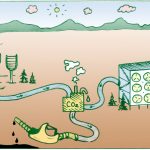Welcome to Monitor Notes, a weekly roundup of news items, event announcements, and updates on past Bay Area Monitor articles.
Money Talks

Transportation funding is often a big ballot issue, and the upcoming November 6 election is no different. We recently wrote about how Californians will decide whether Senate Bill 1’s gas tax increase is repealed. Curious about the implications and outcomes of such “ballot box transportation funding?” Then check out Dr. Martin Wachs, professor emeritus of engineering and planning at UC Berkeley, during a lunchtime discussion in San Jose on Wednesday, October 24, as part of the Mineta Transportation Institute’s Visiting Scholar Series. Drive into your Mineta registration here.
Clear the Atmosphere

Carbon dioxide is a big climate change contributor. So why not take it out of the equation? That’s the idea behind Direct Air Capture (DAC), a way to strip carbon dioxide from the atmosphere. A new Fortune article explains how this method collects and purifies CO2, sometimes even synthesizing it into cleaner transportation fuel. Overall, DAC is an example of how technology continues to evolve to help reduce greenhouse gas levels in the atmosphere. Even working landscapes that the Monitor’s Aleta George wrote about can sequester carbon through photosynthesis.
Setting up Home

Last fall, the Tubbs Fire destroyed more than 5,000 homes and buildings across Sonoma, Napa, and Lake counties. Now, as communities pick up the pieces, they face difficult questions about how and where residents should rebuild. A KQED Science article focusing on Santa Rosa said residents and officials’ alike are wrestling with challenges related to California’s decade-old zoning rules and the region’s severe housing shortage, an issue that has been a priority for policymakers well before the firestorm. Click here to read about the recent efforts to rebuild in at-risk fire zones.
Plunge into Water Policy

Last week’s brief rain is a good reminder that captured stormwater is essential to boosting California’s water supply. It helps cities address flooding and water quality, irrigates landscapes, and recharges aquifers with millions of gallons annually. That’s according to “The Stormwater Opportunity,” a recent blog post by researchers at the Pacific Institute. It lays out how policy is advancing to support the practice and what cities can do so funding trickles in. For historical perspective on state water policy, paddle into Robin Meadows’ 2014 article (featuring the Pacific Institute’s Heather Cooley) from when California was in the thick of a dry spell.
Monitor Notes is produced by Cecily O’Connor. To receive it by email, scroll to the bottom of this page, enter your email address in the box under “RECEIVE EMAIL UPDATES,” and click the red “SIGN UP” button.